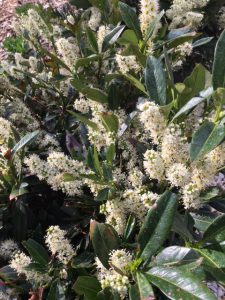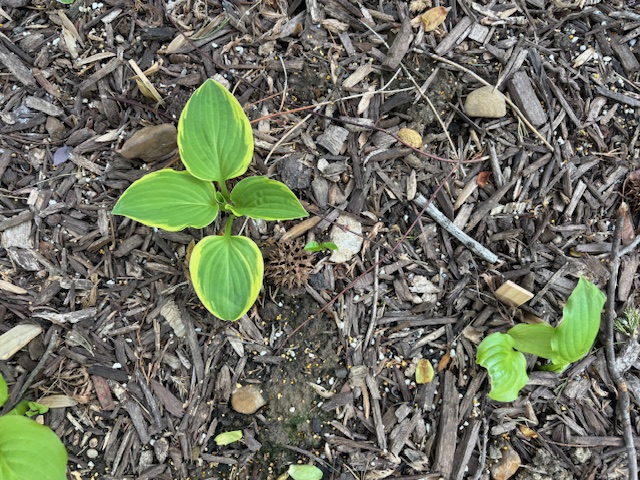Cherry Laurel- Skip and Otto
Views: 6673

When you think of evergreens, perhaps you think of spruce, cedar, pine or yew. They’re trees and shrubs with narrow needle-like foliage that you can drape Christmas lights around during the Holiday season.
In search of an evergreen to screen some ugly utility boxes in our front yard, I was happy to find a different type of evergreen – cherry laurel (Prunus laurocerasus). I thought they were a type of magnolia at first sight, because the leaves are oblong, leathery, dark green and shiny. I was delighted to realize that they will tolerate shade. They don’t like soggy roots. Improve your soil with peat and organic matter before you plant them. Also, don’t plant them in a low spot.
The Schipkaensis (Skip) cultivar grows taller (10-18 feet) and wider (25-30 feet) than Otto (Otto Luyken cultivar) which grows up to 4 feet by 8 feet. They are fast growers, so be sure to space them out properly (something I usually fail to do!) These cultivars are hardy in Zones 6-8, which makes them perfect for southern Indiana.
The tiny, white blooms are displayed on upright racemes (clusters) which seem to be irresistible to pollinators. The tiny black fruit (drupes) attracts birds. The fruit can be eaten by humans, but unfortunately, the leaves, twigs and seeds contain high amounts of hydrocyanic acid and are seriously poisonous. It’s a good idea to just leave the fruit for the birds.
Maintenance
They are disease resistant, but can get Botryosphaeria, a fungi that causes a single branch to die. It can also get Coryneum blight (aka “shot hole”) which leaves circular holes in the leaves. Both these fungal diseases like cool, moist weather, so don’t water or irrigate using overhead sprayers or sprinklers.
These laurels can be pruned or left to grow, but in shadier spots they tend to get leggy. After the flowers have faded, take out any dead, damaged, weak or crossing branches; this will be a trick because the foliage is so dense, it’s difficult to see where you’re cutting. Then, trim about ¼ of an inch above a node on the branch you want to shorten. This will encourage branching and more flowers next year.
If your laurel is older, you may want to do more drastic, rejuvenating pruning. Cut some of the oldest branches all the way back to the ground. Don’t take more than a third of the branches a year.
If the laurel is showing any signs of disease, sterilize your pruners by wiping them down with alcohol between each cut. Clean up all the branches and leaves to prevent any disease from spreading and don’t compost them…just put them in the trash.
Native to Europe, they seem to be well-behaved in southern Indiana, but they have become invasive on the Pacific coast, west of the Cascade Mountains, so keep them around here.
Stay green, Good Friends!
Meet Dona Bergman
Dona Bergman is a founding member, Southwest Indiana Chapter of the Indiana Native Plant & Wildlife Society, and an Advanced Master Gardener.







